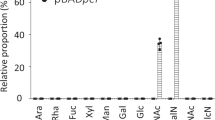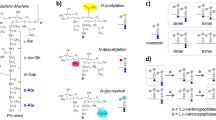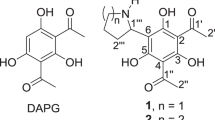Abstract
AFTER capsulated B. anthracis had grown in a modified synthetic medium of Brewer et al.1, a mixture of growth products was isolated from the glass-filtered medium which gave a precipitate with copper sulphate. Crude polyglutamyl peptide was obtained from this precipitate2. An attempt was made to separate the components of the original mixture of growth products by paper electrophoresis using a tank as described by Flynn and Mayo3, and it was found that the peptide could not be detected using naphthalene black, bromo-phenol blue, ninhydrin or ultra-violet light4. We found it could be detected by taking advantage of the acidic nature of the peptide, using the following technique : (1) paper strips with the peptide applied are run in a suitable buffer, for example, veronal/veronal sodium at pH. 8.6 or acetic acid/sodium acetate at pH 4.5, and dried at 100°; (2) the buffer is washed out with two changes of 80 per cent ethanol; (3) the strips are treated with N/50 hydrochloric acid in 90 per cent ethanol; (4) the acid is thoroughly removed with ethanol.; (5) after drying, the strips are dipped into N/300 alcoholic sodium hydroxide containing 0.04 per cent bromo-cresol purple, which is repeated if necessary until colour differentiation is obtained, and the strips are blotted.
This is a preview of subscription content, access via your institution
Access options
Subscribe to this journal
Receive 51 print issues and online access
$199.00 per year
only $3.90 per issue
Buy this article
- Purchase on Springer Link
- Instant access to full article PDF
Prices may be subject to local taxes which are calculated during checkout
Similar content being viewed by others
References
Brewer et al., Arch. Biochem., 10, 65 (1946).
Bovarnick, M., J. Biol. Chem., 145, 415 (1942).
Flynn, F. V., and De Mayo, P., Lancet, ii, 235 (1951).
Phillips, Nature, 161, 53 (1948).
Reid and Lederer, Biochem. J., 50, 60 (1951).
Hanby and Rydon, Biochem. J., 40, 297 (1946).
Consden, Gordon and Martin, Biochem. J., 38, 224 (1944).
Author information
Authors and Affiliations
Rights and permissions
About this article
Cite this article
STRANGE, R., HARKNESS, N. Paper Electrophoresis of Polyglutamyl Peptide. Nature 171, 77–78 (1953). https://doi.org/10.1038/171077a0
Issue Date:
DOI: https://doi.org/10.1038/171077a0
Comments
By submitting a comment you agree to abide by our Terms and Community Guidelines. If you find something abusive or that does not comply with our terms or guidelines please flag it as inappropriate.



